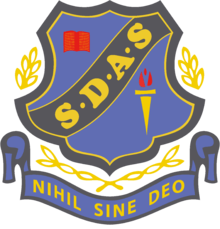Gilson College
| Gilson College | |
|---|---|
 Latin: Nihil Sine Deo "Nothing Without God" | |
| Address | |
|
450 Taylors Road, Taylors Hill 3037 and also 370 Bridge Inn Road, Mernda 3754 Melbourne, Vic Australia | |
| Coordinates | 37°43′27″S 144°45′47″E / 37.72417°S 144.76306°ECoordinates: 37°43′27″S 144°45′47″E / 37.72417°S 144.76306°E |
| Information | |
| Type | Independent & co-educational |
| Denomination | Seventh-day Adventist |
| Established | 1988 |
| Principal | Mr Mark Vodell |
| Teaching staff | 100 |
| Years offered | P-12 |
| Gender | Coeducational |
| Enrolment | approx. 1130 (2016) |
| Website |
gilson |
Gilson College is a dual campus, co-educational day school catering for Foundation to Year 12 with campuses in Mernda and Taylors Hill, Victoria. The original campus located in Taylors Hill was established in 1988. The second campus in Mernda was acquired in December 2012 and classes began in January 2013.
The College is part of the Seventh-day Adventist education system, the world's second largest Christian school system. .[1][2][3][4]
History
Gilson College traces its beginnings to the mid 1970s when a primary school was established in the suburb of Pascoe Vale in Melbourne’s north west. At the end of 1987 the Pascoe Vale school was closed and this heralded the beginning of a new educational institution on the current Taylors Road site. It was established in 1988 and originally known as the 'Keilor School'. In 1992, the school council voted to change the school's name to Gilson College as a tribute to W J Gilson, a prominent figure in Adventist education in Australia. The growth of the Taylors Hill campus has seen the student enrolment go from around 50 students to now over 950.
In 2009 Adventist Schools Victoria closed Ironbark Christian School, which was located in the northern suburbs of Melbourne. In December 2012 a second campus for Gilson College was acquired from the former Acacia College and a similar expansion program is planned for this campus. It caters for Foundation (Prep) to Year 9 (2016) and it will progressively introduce Year 10 and so on through to Year 12.[5]
Principals
The College has had five Principals in its history, those being:[6]
- Lyndon Chapman - 1988
- Ron Hiscox- 1989-1991
- Peter Baskin – 1992-1994
- Chris Cowled – 1995
- Mark Vodell – 1996–Present
Facilities
The Taylors Hill campus is set on 10ha near Caroline Springs, on the western outskirts of Melbourne. The College has in the past 18 years continued to expand its educational line-up, starting with the Science Wing, Library and E-block of classrooms completed in 2000, IT block and Admin office completed in 2003. The original gymnasium/auditorium was demolished recently, to make way for more modern buildings. Each year a building program has added facilities that are now enjoyed by the students and staff. Modern classrooms have been added or renovated. In addition to this, technology laboratories as well as new science facilities provide for the students. A large gymnasium and an eco-science centre are elements of the campus.
The Mernda Campus is set on a 13ha site in the northern suburbs that consists of an Administration block, and an outstanding Junior School complex. The secondary complex is modern and consists of classrooms, science lab, food technology, visual communication room, industrial technology, art room, music and drama rooms.
Site Developments
The Taylors Hill campus has recently completed a six-classroom complex and future developments include a Performing Arts Theatre and a Pre-school.
The Mernda campus has had a number of minor developments including a canteen and future developments will also include a new senior school complex and the redevelopment of the current secondary buildings into a community centre and pre-school.
Enrolment
The College has an open enrolment policy meaning that it accepts students from all faith backgrounds that appreciate and respect the opportunities that come with a Christian education.
Registration is open to all students provided the prerequisites are met. Intake years are usually Foundation or Year 7 while other years are only open subject to the availability of vacancies. The school is registered to take international students.
Curriculum
In 1999, the school first started offering the VCE program on the Taylors Hill campus and now offers over 32 subjects. In the F – 10 years the College follows the Australian Curriculum for the eight learning areas, which focuses on general capabilities and cross-curriculum priorities. In addition to this the College utilises the Encounter program, which uses rigorous pedagogical practice, and 21st century learning strategies, as it explores and develops personal reasons for faith, lifestyle choices, and ethical decision-making from an Adventist worldview, all the while nurturing interpersonal relationships and service to others.[7][8]
my* mission
my* mission is the international humanitarian aid organisation established by Gilson College. Its main focus is the raising of funds to provide teachers to remote village environments in Asia. In addition to this, there is support for two orphanages: Hope and Peace. Each year students at the Year 10 level volunteer as teachers’ aides in classrooms in Asia assisting with English language tuition.
See also
References
- ↑ http://www.csmonitor.com/Commentary/Opinion/2010/1115/For-real-education-reform-take-a-cue-from-the-Adventists"the second largest Christian school system in the world has been steadily outperforming the national average – across all demographics."
- ↑ http://www.religionfacts.com/christianity/denominations/seventh_day_adventist.htm
- ↑ "Department of Education, Seventh-day Adventist Church". Retrieved 2010-06-18.
- ↑ Rogers, Wendi; Kellner, Mark A. (April 1, 2003). "World Church: A Closer Look at Higher Education". Adventist News Network. Retrieved 2010-06-19.
- ↑ Wells, Rachel (2012-11-28). "Seventh Day Adventists buy debt-ridden Acacia College". The Age. Retrieved 2015-08-31.
- ↑ "Gilson College - Our History". www.gilson.vic.edu.au. Retrieved 2015-08-31.
- ↑ "Home - The Australian Curriculum v7.5". www.australiancurriculum.edu.au. Retrieved 2015-08-31.
- ↑ "Adventist Encounter Curriculum". www.encounter.org.au. Retrieved 2015-08-31.
External links
- http://www.privateschoolsguide.com/index.php?option=com_comprofiler&task=userProfile&user=1258&Itemid=96